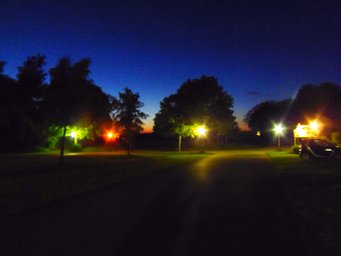Artificial night lighting causes birds to sing earlier
Light pollution influences the seasonal start of bird vocalisations
Under the influence of artificial night lighting, four out of six studied songbird species started dawn and dusk singing earlier in the year. This was shown by scientists of the Max Planck Institute for Ornithology when they studied bird vocalizations from winter to spring in dark sites and in sites exposed to light pollution. An earlier seasonal start of dawn and dusk singing was particularly noticeable in the early risers among the species, suggesting that they are influenced the most by artificial night lighting. Whether the observed effects have consequences for the fitness of the animals remains unknown and needs further investigation.

A negative impact of artificial night lighting on natural populations is now widely recognised and no longer contested. Artificial light at night attracts nocturnal animals, including migrating birds. This can lead to disorientation and is the cause of death of many birds that crash into the lighted objects.
A more subtle effect of artificial night lighting, but one that could have important ecological and evolutionary consequences, is the fact that it disturbs the natural activity rhythms of many animals. For example, diurnal animals are active longer than they normally would be, and birds in cities have even been observed to forage at night during the winter.
However, artificial night lighting not only modifies the daily behaviour of birds, but also their seasonal activity patterns, such as the onset of their reproductive behaviour. For example, blackbirds bred up to one month earlier under the influence of artificial light at night.
Arnaud Da Silva, Mihai Valcu and Bart Kempenaers from the Max Planck Institute for Ornithology in Seewiesen, Germany, studied the dusk and dawn vocalizations of males of six songbird species from Southern Germany: European robin, common blackbird, song thrush, blue tit, great tit, and common chaffinch. These species naturally differ in their seasonal singing behaviour: The two tit species, for which winter singing is more or less common, had already initiated their dawn and dusk choruses when the recordings started. Approximately mid-February, the common chaffinch and the common blackbird started to sing at dawn and dusk, and the European robin joined them by the end of the month. The song thrush was the latest starter, returning from its wintering grounds by the beginning of March.

With daily recordings of bird vocalizations from January to April, the scientists compared six dark habitats and six habitats that were subjected to artificial lighting at night. „Interestingly the effect of artificial night light was largest in the robin and the blackbird, which are the two species that naturally sing earliest at dawn and that are therefore most likely affected by light“ says Arnaud da Silva, lead author of the study. Great tits and – to some extent – also blue tits, also started their dawn and dusk choruses earlier in the year. Only the song thrush started its dawn chorus later in the year in lighted areas, perhaps because they avoided setting up territories there. In the common chaffinch the scientists could not find any effects. The recordings also showed that all species were influenced by the weather in their phenology of dawn and dusk singing: there was much less birdsong on rainy days or days too cold for the time of year.
Dawn and dusk choruses serve to protect and defend the own territory and attract potential mates. „Shifting the singing phenology might have consequences for the fitness of the animals“ says Bart Kempenaers, supervisor of the study. Birds could raise their fitness by shifting their natural rhythm if this would mean that they sire more chicks by breeding earlier in the season. However, such a shift could also be disadvantageous, for example when there is still little food available to raise the young. “What we need now is a more comprehensive understanding of the effects of artificial night light on natural populations. This will help us to develop strategies to minimize the disturbing biological effects“, says Kempenaers.
SSp/EM

